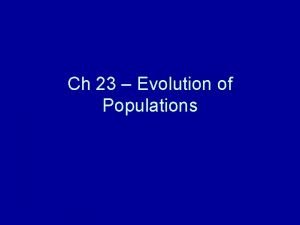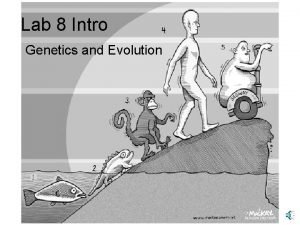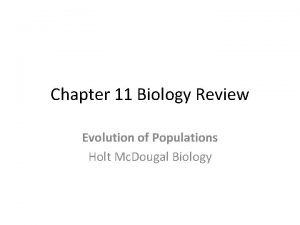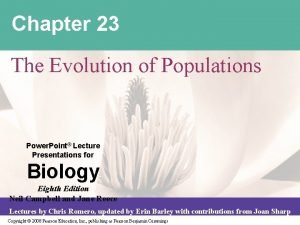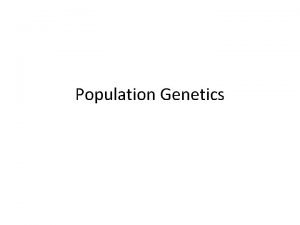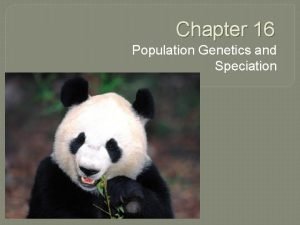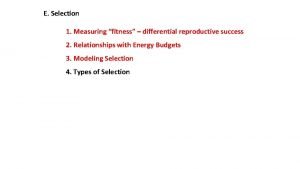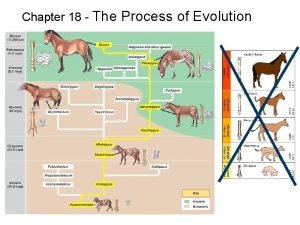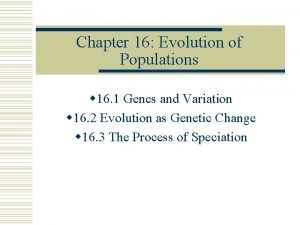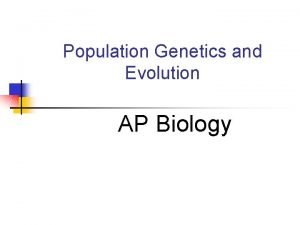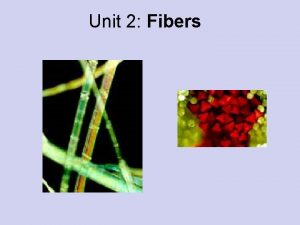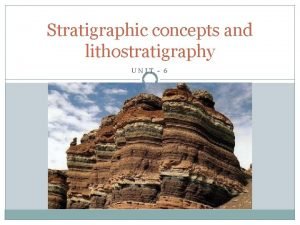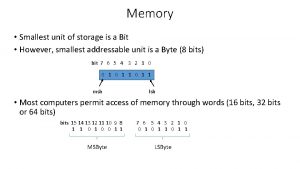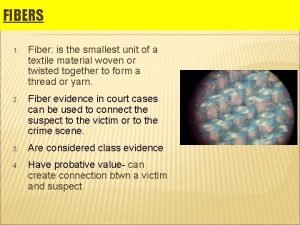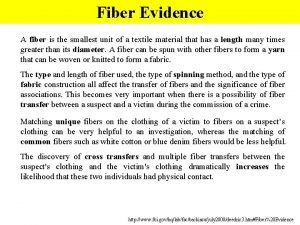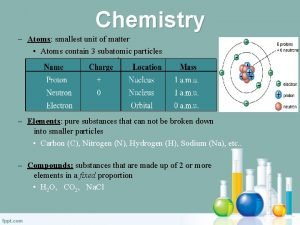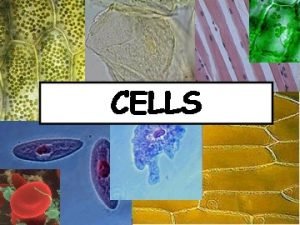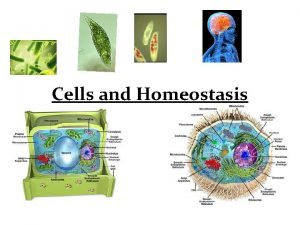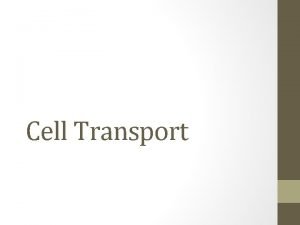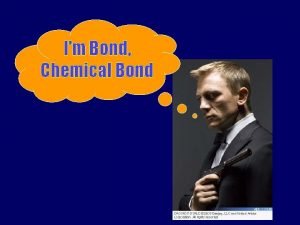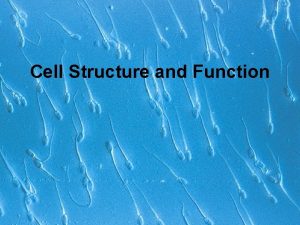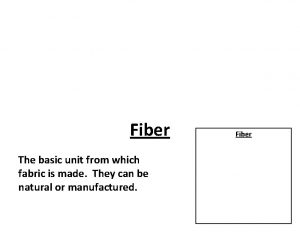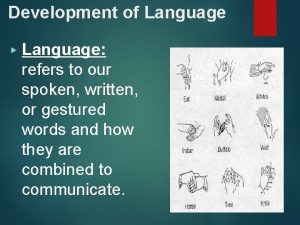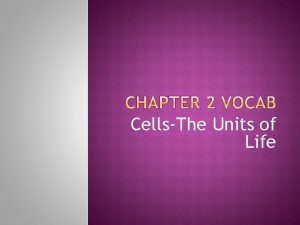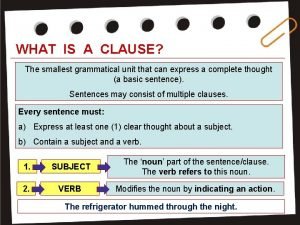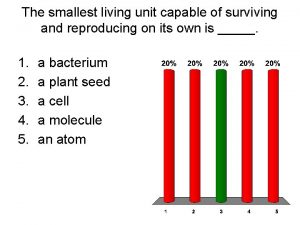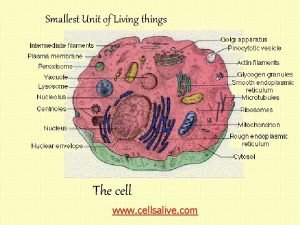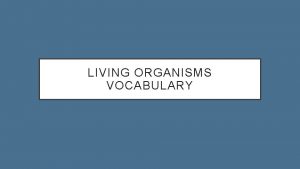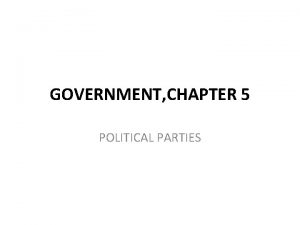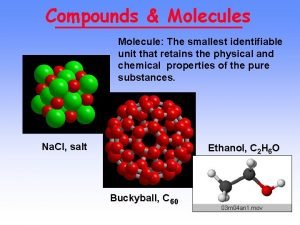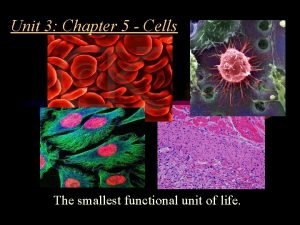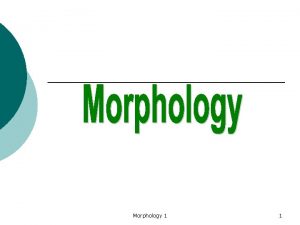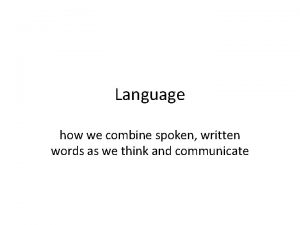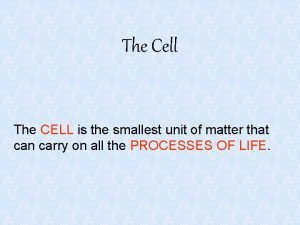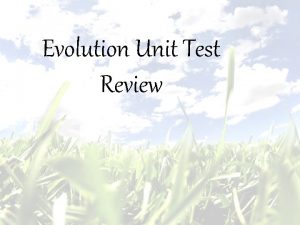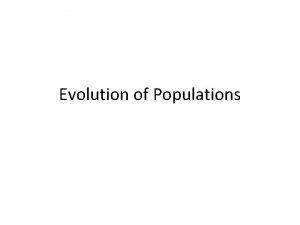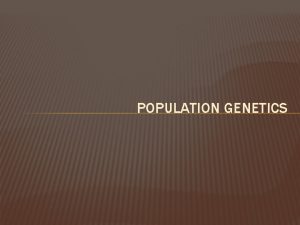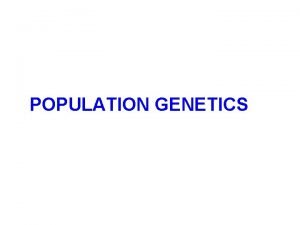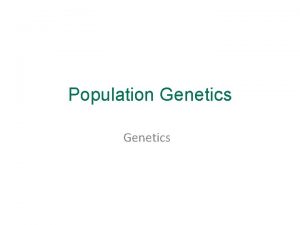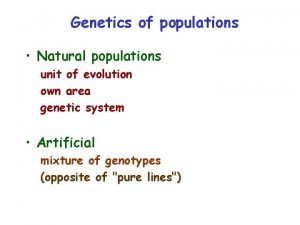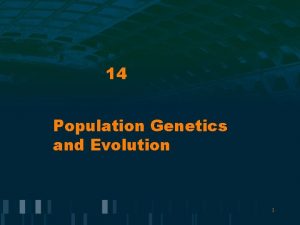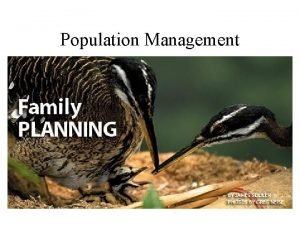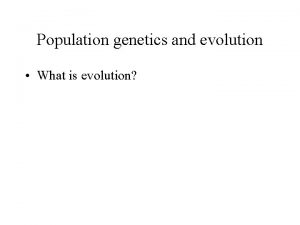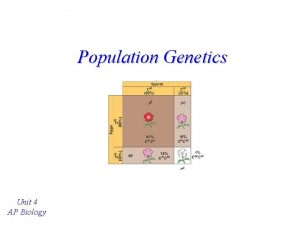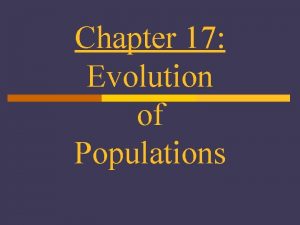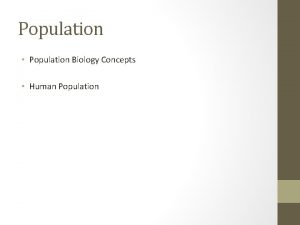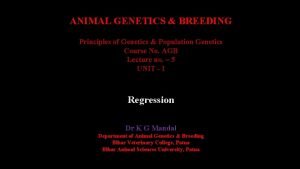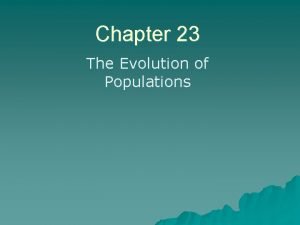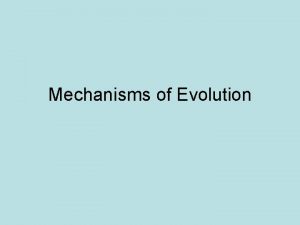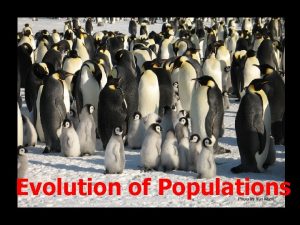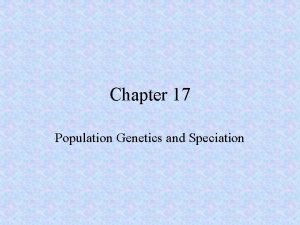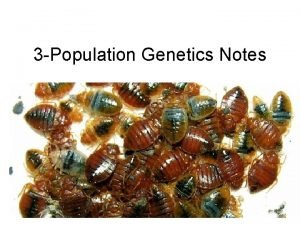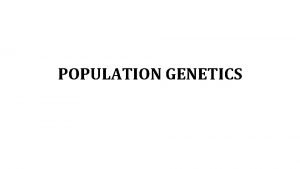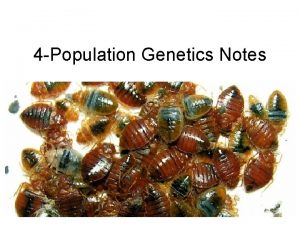Population Genetics Populations The Smallest Unit of Evolution












































































- Slides: 76

Population Genetics

Populations • The Smallest Unit of Evolution • One common misconception about evolution is that individual organisms evolve, in the Darwinian sense, during their lifetimes • Natural selection acts on individuals, but populations evolve

• Genetic variations in populations – Contribute to evolution

• Population genetics provides a foundation for studying evolution • Microevolution – Is change in the genetic makeup of a population from generation to generation

The Modern Synthesis • Population genetics – Is the study of how populations change genetically over time

• The modern synthesis – Integrates Mendelian genetics with the Darwinian theory of evolution by natural selection

• The Modern Synthesis emphasizes • populations as units of evolution – Natural selection is an important mechanism of adaptive evolution – Gradualism explains how large changes can evolve as an accumulation of small changes over time

Gene Pools and Allele Frequencies • A population – Is a localized group of individuals that are capable of interbreeding and producing fertile offspring

• The gene pool – Is the total aggregate of genes in a population at any one time – Consists of all gene loci in all individuals of the population

• If only one allele exists at a particular locus in a population – All individuals are homozygous (fixed allele) • If two or more alleles for a particular locus – Individuals are either homozygous or heterezygous

Gene Pool A, a, B, b, C, c, D, d AA BB Aa Bb aa bb CC Cc cc DD Dd dd

• Each allele has a frequency in the population’s gene pool • Example: – Population size = 500 wildflowers – Alleles for flower pigment: CR (red), CW (white)

– 20 individuals (4%) white flowers - CW CW – 320 individuals (64%) red flowers - CR CR – 160 individuals (32%) pink flowers - CR CW • In diploid organisms there are two alleles at a particular locus (500 x 2 =1000 alleles) – CW C W 20 x 2 = 40 CW alleles – CR C R 320 x 2 = 640 CR alleles – CW CR 160 CR alleles + 160 CW alleles

• p = frequency of the CR – (640 +160)/1000 = 0. 8 • q = frequency of the CW – (40+160)/1000 = 0. 2

The Hardy-Weinberg Theorem – States that the frequencies of alleles and genotypes in a population’s gene pool remain constant from generation to generation provided that only Mendelian segregation and recombination of alleles are at work

• Preservation of Allele Frequencies – The Hardy-Weinberg Theorem describes how Mendelian inheritance preserves genetic variation in populations that are not evolving • Meiosis • Random fertilization – In a given population where gametes contribute to the next generation randomly, allele frequencies will not change

Hardy-Weinberg Equilibrium • Describes a population in which random mating occurs • Describes a population where allele frequencies do not change – Genotype frequencies can be predicted from the allele frequencies – A population in a state of Hardy-Weinberg equilibrium

• If p and q represent the relative frequencies of the only two possible alleles in a population at a particular locus, then – p 2 + 2 pq + q 2 = 1 – And p 2 and q 2 represent the frequencies of the homozygous genotypes and 2 pq represents the frequency of the heterozygous genotype

• Wildflower population • CR x C R = p 2 • CW x C W = q 2 • (CR x CW) + (CW x CR) = 2 pq – Genotype frequencies • p 2 = (0. 8)2 = 0. 64 • q 2 = (0. 2)2 = 0. 04 • 2 pq = 2 (0. 8 x 0. 2) = 0. 32

Conditions for Hardy-Weinberg Equilibrium • The Hardy-Weinberg theorem – Describes a hypothetical population • In real populations – Allele and genotype frequencies do change over time

• The five conditions for non-evolving populations are rarely met in nature – Extremely large population size • Genetic drift – Chance fluctuations in small populations – No gene flow • No transfer of alleles between populations – No mutations – Random mating – No natural selection

Population Genetics and Human Health • We can use the Hardy-Weinberg equation – To estimate the percentage of the human population carrying the allele for an inherited disease

• PKU (phenylketonuria) – Recessive allele – Frequency of homozygous recessive in the U. S. • 1/10, 000 = 0. 0001 = q 2 • √ 0. 0001 = 0. 01 = q • p+q=1 • p = 1 - q • p = 1 - 0. 01 = 0. 99

• PKU – Frequency of carriers (heterozygotes) – 2 pq – 2 X 0. 99 X 0. 01 = 0. 0198 • ~ 2% of the U. S. population carries the PKU allele

• Mutation and sexual recombination produce the variation that makes evolution possible – these processes produce the variation in gene pools that contributes to differences among individuals

Mutation • Mutations – Are changes in the nucleotide sequence of DNA – Cause new genes and alleles to arise

Point Mutations • A point mutation – Is a change in one base in a gene – Can have a significant impact on phenotype – Is usually harmless, but may have an adaptive impact

Mutations That Alter Gene Number or Sequence • Chromosomal mutations that affect many loci – Are almost certain to be harmful – May be neutral and even beneficial • Link genes that acts together to positive effect

• Gene duplication – Duplicates chromosome segments • Nearly always harmful

• Small pieces of DNA can be introduced into the genome through the activity of transposons • Can persist over generations and provide new loci for “new” genes • Exon shuffling • Another source of new genes

Mutation Rates • Mutation rates – Tend to be low in animals and plants • Average about one mutation in every 100, 000 genes per generation – Are more rapid in microorganisms

Sexual Recombination • In sexually reproducing populations, sexual recombination – Is far more important than mutation in producing the genetic differences that make adaptation possible – Recombination reshuffles alleles but does nor change their frequency

• Changes in allele frequencies bring about most evolutionary change – Three major factors alter allele frequencies, thus a population’s genetic composition • Natural selection • Genetic drift • Gene flow

Natural Selection • Differential success in reproduction – Results in certain alleles being passed to the next generation in greater proportions

Genetic Drift • Statistically, the smaller a sample – The greater the chance of deviation from a predicted result

• Genetic drift – Describes how allele frequencies can fluctuate unpredictably from one generation to the next – Tends to reduce genetic variation

The Bottleneck Effect • In the bottleneck effect – A sudden change in the environment may drastically reduce the size of a population – The gene pool may no longer be reflective of the original population’s gene pool

• Understanding the bottleneck effect – Can increase understanding of how human activity affects other species

The Founder Effect • The founder effect – Occurs when a few individuals become isolated from a larger population – Can affect allele frequencies in a population

• the Afrikaner population of Dutch settlers in South Africa is descended mainly from a few colonists – Today, the Afrikaner population has an unusually high frequency of the gene that causes Huntington’s disease – the original Dutch colonists just happened to carry that gene with unusually high frequency

• In the 18 th century a few hundred German. Swiss settlers brought the Amish and Mennonite faiths to the United States – nearly 150, 000 Amish in America can trace their roots back to these immigrants – Over generations of intermarriage, rare genetic disorders have shown up among the Amish

Gene Flow • Gene flow – Causes a population to gain or lose alleles – Results from the movement of fertile individuals or gametes – Tends to reduce differences between populations over time

Genetic Variation • Natural selection leads to adaptation of an organism to its environment – Natural selection accumulates and maintains favorable genotypes in a population – Most populations have extensive genetic variation

Genetic Variation • Individual variation occurs in populations of all species – Individual phenotypic variations reflect a unique genome – Not all phenotypic variation is heritable • Phenotype is the cumulative product of inherited genotype and environmental influences

Variation Within a Population • Both discrete and quantitative characters – Contribute to variation within a population

• Discrete characters – Can be classified on an either-or basis • Quantitative characters – Vary along a continuum within a population

• Phenotypic polymorphism – Describes a population in which two or more distinct morphs for a character are each represented in high enough frequencies to be readily noticeable – Polymorphisms only applies to discrete characters

• Genetic polymorphisms – Are the heritable components of characters that occur along a continuum in a population

• Measuring Genetic Variation • Population geneticists – Measure the number of polymorphisms in a population by determining the amount of heterozygosity • gene level (gene variability) • molecular level (nucleotide variability)

• Average heterozygosity • Measures the average percent of loci that are heterozygous in a population • Nucleotide variability – Measures the mean level of difference between nucleotide sequences (base pair differences)

Variation Between Populations • Most species exhibit geographic variation – Differences between gene pools of separate populations or population subgroups

• Geographic variation – Results from differences in genotypes or genotypes between populations or between subgroups of a single population that inhabit different areas – Can occur within a population on a local scale • Spatial variation – A patchy environment or limited dispersal of individuals leads to subpopulations

Gene Pool: A, a, B, b, C, c, D, d Aa BB BB aa Bb Aa CC dd Cc Dd Dd Dd dd dd DD dd Aa Aa bb bb CC CC CC Cc CC Dd Dd Dd Aa Aa BB Bb CC CC CC Cc CC CC CC DD dd dd dd aa aa aa Aa Bb Bb Cc Cc Cc DD DD Dd Aa AA bb bb bb BB Cc Cc CC Dd Dd

• Some examples of geographic variation occur as a cline – a graded change in a trait along a geographic axis

– Clines may represent a graded region of overlap • Neighboring populations interbreed – Clines may be produced by a gradation in some environmental variable • Body size of birds and mammal increases gradually with increasing latitude

Evolutionary Adaptation • From the range of variations available in a population – Natural selection increases the frequencies of certain genotypes, fitting organisms to their environment over generations – Natural selection is a mechanism of evolutionary adaptation

Evolutionary Fitness • The phrases “struggle for existence” and “survival of the fittest” – Are commonly used to describe natural selection – Can be misleading • Reproductive success – Is generally more subtle and depends on many factors

• Adaptive advantages are components of fitness – the contribution an individual makes to the gene pool of the next generation, relative to the contributions of other individuals

– Relative fitness • Is the contribution of a genotype to the next generation as compared to the contributions of alternative genotypes for the same locus • The relative fitness of reproductively successful variants is set at 1 as a basis of comparison

Directional, Disruptive, and Stabilizing Selection • Selection – Favors certain genotypes by acting on the phenotypes of certain organisms • Three modes of selection are – Directional – Disruptive – Stabilizing

• Directional selection – Favors individuals at one end of the phenotypic range • Disruptive selection – Favors individuals at both extremes of the phenotypic range • Stabilizing selection – Favors intermediate variants and acts against extreme phenotypes

The Preservation of Genetic Variation • Various mechanisms help to preserve genetic variation in a population

Diploidy • Diploidy – Maintains genetic variation in the form of hidden recessive alleles

Balancing Selection • Balancing selection – Occurs when natural selection maintains stable frequencies of two or more phenotypic forms in a population – Leads to a state called balanced polymorphism • Heterozygote advantage • Frequency-dependent selection

• Heterozygote Advantage – Some individuals who are heterozygous at a particular locus • Have greater fitness than homozygotes – Natural selection will tend to maintain two or more alleles at that locus

• The sickle-cell allele – Causes mutations in hemoglobin but also confers malaria resistance – Exemplifies the heterozygote advantage

• Frequency-Dependent Selection – In frequency-dependent selection the fitness of any morph declines if it becomes too common in the population • “search image”

• Neutral variation – Is genetic variation that appears to confer no selective advantage – Pseudogenes • Genes that have become inactivated by mutations

• Sexual selection – Is natural selection for mating success – Can result in sexual dimorphism, marked differences between the sexes in secondary sexual characteristics

• Intrasexual selection – Selection “within the same sex” – Is a direct competition among individuals of one sex for mates of the opposite sex

• Intersexual selection (mate choice) – Occurs when individuals of one sex (usually females) are choosy in selecting their mates from individuals of the other sex – May depend on the showiness of the male’s appearance

Evolution of Sexual Reproduction • Sexual reproduction – Produces fewer reproductive offspring than asexual reproduction, a so-called reproductive handicap

• If sexual reproduction is a handicap, why has it persisted? – It produces genetic variation that may aid in disease resistance • most pathogens evolve rapidly in their ability to key on specific host receptors • sex provides a mechanism for “changing the locks” and varying them among offspring

• Coevolution between host and parasite – Must evolve quickly to keep up with each other • “Red Queen race” – The Red Queen advised Alice to run as fast as she could just to stay in the same place • Through the looking Glass by Lewis Carroll

Why Natural Selection Cannot Fashion Perfect Organisms • Evolution is limited by historical constraints – Existing structures are adapted to new situations • wings and four legs in birds? • Adaptations are often compromises – Organisms do many different things • flippers or legs for seals?

• Chance and natural selection interact – alleles present in a founder population are not necessarily the best to the environment • Selection can only edit existing variations – It favors the fittest genotypes which may not be the ideal traits
 Why are populations the smallest unit of evolution
Why are populations the smallest unit of evolution Lab 8 population genetics and evolution
Lab 8 population genetics and evolution Stabilizing selection human birth weight
Stabilizing selection human birth weight Chapter 16 evolution of populations vocabulary review
Chapter 16 evolution of populations vocabulary review Chapter 17 evolution of populations answer key
Chapter 17 evolution of populations answer key Chapter 23: the evolution of populations
Chapter 23: the evolution of populations Evolution of populations section 16-1 genes and variation
Evolution of populations section 16-1 genes and variation Chapter 16 evolution of populations
Chapter 16 evolution of populations Evolution of populations section 11 review
Evolution of populations section 11 review Chapter 23 the evolution of populations
Chapter 23 the evolution of populations What is fst
What is fst Population genetics and speciation worksheet answer key
Population genetics and speciation worksheet answer key Modern synthesis
Modern synthesis Population genetics
Population genetics Population genetics
Population genetics Population genetics definition
Population genetics definition Chapter 4 section 1 population dynamics answer key
Chapter 4 section 1 population dynamics answer key Population ecology section 1 population dynamics
Population ecology section 1 population dynamics Population ecology section 1 population dynamics
Population ecology section 1 population dynamics Population ecology section 1 population dynamics answer key
Population ecology section 1 population dynamics answer key The smallest unit of a textile is called a fiber
The smallest unit of a textile is called a fiber Lateral continuity
Lateral continuity Smallest unit of memory
Smallest unit of memory The smallest unit of fabric is called
The smallest unit of fabric is called The smallest unit of a textile
The smallest unit of a textile Are atoms the smallest unit of matter
Are atoms the smallest unit of matter Steenblock
Steenblock The smallest unit of life is
The smallest unit of life is Cells are the smallest unit of life
Cells are the smallest unit of life Smallest living unit
Smallest living unit Whats the smallest unit of matter
Whats the smallest unit of matter What is the smallest addressable unit of memory?
What is the smallest addressable unit of memory? Smallest unit of metallic bond
Smallest unit of metallic bond The smallest unit of a textile material is called a:
The smallest unit of a textile material is called a: What is the smallest living unit in the body
What is the smallest living unit in the body The smallest living unit is
The smallest living unit is The smallest unit of an ionic compound is a
The smallest unit of an ionic compound is a The basic unit in the construction of textiles
The basic unit in the construction of textiles The smallest distinctive sound unit of language is a
The smallest distinctive sound unit of language is a What unit of size are the smallest organisms found on earth
What unit of size are the smallest organisms found on earth The smallest unit of a sentence
The smallest unit of a sentence Smallest living unit
Smallest living unit Dittulgia
Dittulgia What is the smallest unit of living organisms
What is the smallest unit of living organisms Economic protest parties definition
Economic protest parties definition What is the smallest identifiable unit of a compound
What is the smallest identifiable unit of a compound What is the smallest living unit of life
What is the smallest living unit of life Smallest functional unit of life *
Smallest functional unit of life * Jack in
Jack in Art of combining spoken and written words
Art of combining spoken and written words A cell is the smallest unit of
A cell is the smallest unit of The smallest unit of charge is
The smallest unit of charge is What is the smallest unit of a metallic bond
What is the smallest unit of a metallic bond Unit 10, unit 10 review tests, unit 10 general test
Unit 10, unit 10 review tests, unit 10 general test Evolution unit test
Evolution unit test Unit 10 quiz 2
Unit 10 quiz 2 Hình ảnh bộ gõ cơ thể búng tay
Hình ảnh bộ gõ cơ thể búng tay Slidetodoc
Slidetodoc Bổ thể
Bổ thể Tỉ lệ cơ thể trẻ em
Tỉ lệ cơ thể trẻ em Gấu đi như thế nào
Gấu đi như thế nào Tư thế worm breton
Tư thế worm breton Hát lên người ơi
Hát lên người ơi Kể tên các môn thể thao
Kể tên các môn thể thao Thế nào là hệ số cao nhất
Thế nào là hệ số cao nhất Các châu lục và đại dương trên thế giới
Các châu lục và đại dương trên thế giới Công thức tiính động năng
Công thức tiính động năng Trời xanh đây là của chúng ta thể thơ
Trời xanh đây là của chúng ta thể thơ Mật thư anh em như thể tay chân
Mật thư anh em như thể tay chân Phép trừ bù
Phép trừ bù độ dài liên kết
độ dài liên kết Các châu lục và đại dương trên thế giới
Các châu lục và đại dương trên thế giới Thể thơ truyền thống
Thể thơ truyền thống Quá trình desamine hóa có thể tạo ra
Quá trình desamine hóa có thể tạo ra Một số thể thơ truyền thống
Một số thể thơ truyền thống Cái miệng nó xinh thế
Cái miệng nó xinh thế Vẽ hình chiếu vuông góc của vật thể sau
Vẽ hình chiếu vuông góc của vật thể sau
